A 1.8 m Class Pathfinder Raman LIDAR for the Northern Site of the Cherenkov Telescope Array Observatory—Performance
Abstract
1. Introduction
- Cloud properties: The RL shall detect clouds in an altitude range from 2 km to 20 km above ground within a cloud Vertical Optical Depth (VOD) range of 0.01 < VOD < 0.7. It shall measure VOD for the detected clouds with an accuracy equal to or better than 0.03 root mean square deviation (RMSD) for each laser wavelength. It shall also measure base and top heights for the detected clouds with an accuracy equal to or better than 300 m RMSD.
- PBL properties: The RL shall detect the PBL with heights ranging from 0.5 km to 9 km above ground and Vertical Aerosol Optical Depths (VAODs) ranging from 0.03 to 0.7. It shall provide VAODs for the detected PBL with an accuracy equal to or better than 0.03 RMSD for each laser wavelength. It shall also measure the heights of detected PBLs with an accuracy equal to or better than 300 m RMSD. It shall measure the extinction Ångström exponent with an accuracy better than 0.3 RMSD.
- Pointing capability: The RL shall have a range of pointing directions starting from 25° or lower elevation angles up to zenith and be applicable to all azimuth angles.
- Measurement time: To limit interference with CTAO science observations, the RL shall measure the aerosol extinction profile to the required accuracy along any line-of-sight within the pointing limits within one minute or less.
1.1. Pathfinder Barcelona Raman LIDAR
1.2. Datataking Campaigns
2. Methods
2.1. Performance Simulation Using the Return Power Budget Method
2.1.1. Return Power
2.1.2. Signal to Noise Ratio
2.2. Pre-Process Analysis
- LPP analysis: The actual core of the program.
- Graphical User Interface (GUI): Implementation of a user-friendly interface with a finalized design using front-end technologies.
- Logging and configuration: A comprehensive logging system with database entries and the generation of log files. Configuration options through YAML files, including auto-update capabilities and GUI configurability.
- Testing: Execution of Continuous Integration (CI) tests covering GUI, HTTP interactions, database connections, and specific functionalities. In addition, ample possibilities are provided for manual testing on diverse datasets for all LPP analysis steps.
- Molecular Density Profile (MDP): A downloader component for molecular density profiles from the European Centre for Medium-Range Weather Forecasts (ECWMF) or the Global Forecast System (GFS) at a given location on Earth and time.
2.2.1. Raw Data Sanity Checks
2.2.2. Time Offset Adjustments
2.2.3. Photon Background and Offset Determination
- Ion feedback from the photocathode or atmospheric muons traversing the photomultiplier can create spurious high signals, particularly in the amplitude channel, even in the absence of backscattered laser light.
- The exact ranges of signal-free data are unknown a priori. Contamination of those regions used for background estimation with signal (e.g., from spurious reflection of laser light on the guide mirrors or late atmospheric backscatter) must be avoided.
2.3. Analog to Photon-Counting Signal Gluing
2.3.1. -Based Gluing
- Identify the maximum range and prepare the data: the last index within the valid gluing range is stored; this sets the upper bound for processing. Then, the gluing window sizes are divided into batches of window sizes. Each batch contains one value for sequential processing, with each batch running in parallel.
- Create a pool of processes: the multiprocessing pool is initialized with the number of CPU cores available, allowing the algorithm to utilize all processing resources effectively. The batches are created as tuples of values and the corresponding channel ID, then these are the input for each parallel process.
- Parallel execution: the pool distributes the batches across the CPU cores, calling the batch process function for each batch. This function iterates over each in the batch and executes the minimization of the , Equation (17). This setup allows each core to handle a different in parallel, greatly speeding up the computation.
- Collect results: Once all batches have been processed, the results from each batch are stored and flattened into individual results, which contain the minimization results.
2.3.2. Likelihood-Based Gluing
2.3.3. Range-Corrected Signal
2.4. Dynamic Rebinning
2.5. Profile Retrieval
- System constant. We precalculate a system constant , which can be obtained either analytically, if the system is sufficiently well characterized, or through an absolute LIDAR calibration [9]:where is the average molecular backscatter coefficient at the altitude of the site, and the other parameters have been introduced in Equations (1) and (4).
2.5.1. Molecular Profile
2.5.2. Molecular Atmosphere Ranges
2.5.3. Ground Layer
2.5.4. Cloud Layer
- Search for cloud’s lower bound. The algorithm scans the precomputed values and (see Equations (45) and (46)). If the reduced molecular fit exceeds a predefined threshold of 3.5 and at the same time , the algorithm considers this a potential cloud base. Both conditions require a significant positive deviation from the molecular backscatter profile, as expected for clouds. In the case of the (search for the) lowest cloud layer, is chosen to be ; otherwise, a new reference constant needs to be taken for the free troposphere from above the last cloud layer below. The lower bound of the cloud is then refined by moving back downwards again until the reduced molecular fit falls (again) below 1.5 and . This part ensures that the signal transitions smoothly to the free troposphere. The previous step marks the cloud base height , and with it a reference .
- Identification of cloud’s top. To find the height of the cloud top, the algorithm continues to scan the reduced molecular fit upwards and stops when it falls again below 2.2 and , ensuring that the cloud candidate absorbs light w.r.t. the molecular atmosphere part. From that point on, the algorithm moves further upwards as long as the ’s decrease with respect to their immediate predecessor . This part ensures that possible exponential drops of cloud density on their upper edges are correctly attributed to the cloud and not the free troposphere. The end of that step results in a cloud top height , and with it a reference . For a detected cloud, the VOD is calculated [66]:
- Handling misidentified clouds. At this point, the algorithm carries out several checks to detect and discard false positives: (i) Clouds with discarded. (ii) Cloud with and geometric thickness m are considered statistical fluctuations and discarded. (iii) Frequent temperature fluctuations and inversion in the tropopause [67] are excluded by requiring that any cloud with km above ground (14.2 km a.s.l.) shows a geometric thickness larger than 4 km and .
- Extinction and LIDAR ratio calculation. As in the case of the ground layer inversion, the reference point at is exchanged by , and the Klett–Fernald algorithm [61,62,63] used for the inversion. The inversion is performed iteratively refining a global cloud LIDAR Ratio, until the integrated extinction profile matches . The LIDAR Ratio is, nevertheless, constrained to between limits of 5 Sr and 120 Sr. If the ratio fails to converge within a maximum number of iterations, the algorithm uses the nearest limit and rescales the extinction coefficients.
2.5.5. Raman Lines
3. Results
3.1. Data Sets
- D-I The night of 5 July 2018 at the UAB campus.
- D-II The night of 18 March 2022 at ORM, with clean atmospheric conditions. This should resemble the standard for CTAO operations.
- D-III During the last two weeks of August 2021, an approximately ten-day-long Saharan dust intrusion event occurred, the so-called calima [21]. Calima breached the usually stable inversion layer and significantly degraded air quality above the observatory. In the first days, the mineral dust concentration was so high that multiple scatterings made an accurate analysis of the constituent aerosols almost impossible. In the last days of the event, when Saharan dust spread over a large part of the Atlantic Ocean (see Figure 21), the concentration of scatterers decreased. The analysis presented here refers to data collected in the evenings of 25 and 26 of August 2021.
- D-IV On 19 September 2021, the Tajogaite volcano on the Cumbre Vieja mountain ridge erupted in the southern part of the La Palma island. The volcano was located at a distance of about 14 km toward the south-south-east of the ORM. In the following days, a dust plume spread over the whole island. During the measurements in the evening of 22 September 2021, a vertical scan of the sky was performed. Figure 22 shows satellite data taken during that event.
3.2. Range-Height-Indication (RHI) Diagram
3.3. RCS, Extinction, Backscatter Coefficients, and Ångström Exponent Profiles
3.4. Temporal Evolution of Atmospheric Properties
3.5. Maximum Range
4. Discussion
5. Conclusions
Author Contributions
Funding
Data Availability Statement
Acknowledgments
Conflicts of Interest
References
- Acharya, B.S.; Actis, M.; Aghajani, T.; Agnetta, G.; Aguilar, J.; Aharonian, F.; Ajello, M.; Akhperjanian, A.; Alcubierre, M.; Aleksić, J.; et al. Introducing the CTA concept. Astropart. Phys. 2013, 43, 3–18. [Google Scholar] [CrossRef]
- The Cherenkov Telescope Array Consortium. Science with the Cherenkov Telescope Array; The CTA Consortium, Ed.; World Scientific: Singapore, 2019; p. 364. [Google Scholar] [CrossRef]
- Aleksić, J.; Alvarez, E.A.; Antonelli, L.A.; Antoranz, P.; Asensio, M.; Backes, M.; Barrio, J.A.; Bastieri, D.; González, J.B.; Bednarek, W.; et al. Performance of the MAGIC stereo system obtained with Crab Nebula data. Astropart. Phys. 2012, 35, 435–448. [Google Scholar] [CrossRef]
- Aharonian, F.; Akhperjanian, A.G.; Bazer-Bachi, A.R.; Beilicke, M.; Benbow, W.; Berge, D.; Bernlöhr, K.; Boisson, C.; Bolz, O.; Borrel, V.; et al. Observations of the Crab nebula with HESS. Astrononmy Astrophsics 2006, 457, 899–915. [Google Scholar] [CrossRef]
- Gaug, M. CTA Atmospheric Calibration. Eur. Phys. J. Web Conf. 2017, 144, 01003. [Google Scholar] [CrossRef]
- Ballester, O.; Blanch, O.; Boix, J.; Bregeon, J.; Brun, P.; Çolak, S.M.; Doro, M.; Da Deppo, V.; Font, L.; Gabella, O.; et al. Raman LIDARs for the atmospheric calibration along the line-of-sight of CTA. In Proceedings of the 36th International Cosmic Ray Conference—ICRC2019, Madison, WI, USA, 24 July–1 August 2019; Volume PoS(ICRC2019)814. [Google Scholar]
- Ebr, J.; Karpov, S.; Eliášek, J.; Blažek, J.; Cunniffe, R.; Ebrová, I.; Janeček, P.; Jelínek, M.; Juryšek, J.; Mandát, D.; et al. A New Method for Aerosol Measurement Using Wide-field Photometry. Astron. J. 2021, 162, 6. [Google Scholar] [CrossRef]
- Laken, B.A.; Parviainen, H.; García-Gil, A.; Muñoz-Tuñón, C.; Varela, A.M.; Fernandez-Acosta, S.; Pallé, P. Thirty Years of Atmospheric Extinction from Telescopes of the North Atlantic Canary Archipelago. J. Clim. 2016, 29, 227–240. [Google Scholar] [CrossRef]
- Fruck, C.; Gaug, M.; Hahn, A.; Acciari, V.; Besenrieder, J.; Dominis Prester, D.; Dorner, D.; Fink, D.; Font, L.; Mićanović, S.; et al. Characterizing the aerosol atmosphere above the Observatorio del Roque de los Muchachos by analysing seven years of data taken with an GaAsP HPD-readout, absolutely calibrated elastic LIDAR. MNRAS 2022, 515, 4520–4550. [Google Scholar] [CrossRef]
- Lombardi, G.; Zitelli, V.; Ortolani, S.; Ghedina, A.; Garcia, A.; Molinari, E.; Gatica, C. New dust measurements at ORM, and comparison with Paranal Observatory. Ground-Based Airborne Telesc. III 2010, 7733, 77334G. [Google Scholar] [CrossRef]
- Otarola, A.; Hickson, P. Study of cirrus clouds and implications for the variability of laser guide star intensity and fratricide effects. In Proceedings of the Fifth AO4ELT Conference, Puerto de La Cruz, Tenerife, Canary Islands, Spain, 25–30 June 2017. [Google Scholar] [CrossRef]
- Hellemeier, J.A.; Yang, R.; Sarazin, M.; Hickson, P. Weather at selected astronomical sites—An overview of five atmospheric parameters. Mon. Not. R. Astron. Soc. 2019, 482, 4941–4950. [Google Scholar] [CrossRef]
- Schmuckermaier, F.; Gaug, M.; Fruck, C.; Moralejo, A.; Hahn, A.; Prester, D.D.; Dorner, D.; Font, L.; Mićanović, S.; Mirzoyan, R.; et al. Correcting Imaging Atmospheric Cherenkov Telescope data with atmospheric profiles obtained with an elastic light detecting and ranging system. A&A 2023, 673, A2. [Google Scholar] [CrossRef]
- Pecimotika, M.; Dominis Prester, D.; Hrupec, D.; Mićanović, S.; Pavletić, L.; Sitarek, J. Performance and systematic uncertainties of CTA-North in conditions of reduced atmospheric transmission. J. Cosmol. Astropart. Phys. 2023, 2023, 011. [Google Scholar] [CrossRef]
- Dominis Prester, D.; Ebr, J.; Gaug, M.; Hahn, A.; Babić, A.; Eliášek, J.; Janeček, P.; Karpov, S.; Kolarek, M.; Manganaro, M.; et al. Characterisation of the Atmosphere in Very High Energy Gamma-Astronomy for Imaging Atmospheric Cherenkov Telescopes. Universe 2024, 10, 349. [Google Scholar] [CrossRef]
- Ballester, O.; Blanch, O.; Boix, J.; Calisse, P.G.; Campoy-Ordaz, A.; Çolak, S.M.; Da Deppo, V.; Doro, M.; Font, L.; Font-Pladevall, E.; et al. A 1.8 m class pathfinder Raman lidar for the Northern Site of the Cherenkov Telescope Array—Technical Design. Remote Sens. 2025, 17, 1074. [Google Scholar] [CrossRef]
- Sicard, M.; Reba, M.N.M.; Tomás, S.; Comerón, A.; Batet, O.; Muñoz-Porcar, C.; Rodríguez, A.; Rocadenbosch, F.; Muñoz-Tuñón, C.; Fuensalida, J.J. Results of site testing using an aerosol, backscatter lidar at the Roque de los Muchachos Observatory. Mon. Not. R. Astron. Soc. 2010, 405, 129–142. [Google Scholar] [CrossRef]
- Hillas, A.M.; Patterson, J.R. Characteristics and brightness of Cerenkov shower images for gamma-ray astronomy near 1 TeV. J. Phys. G-Nucl. Part. Phys. 1990, 16, 1271–1281. [Google Scholar] [CrossRef]
- Garrido, D.; Gaug, M.; Doro, M.; Font, L.; López-Oramas, A.; Moralejo, A. Influence of atmospheric aerosols on the performance of the MAGIC telescopes. arXiv 2013, arXiv:1308.0473. [Google Scholar] [CrossRef]
- Lombardi, G.; Zitelli, V.; Ortolani, S.; Pedani, M.; Ghedina, A. El Roque de Los Muchachos site characteristics. III. Analysis of atmospheric dust and aerosol extinction. A&A 2008, 483, 651–659. [Google Scholar] [CrossRef]
- Barreto, A.; Cuevas, E.; García, R.D.; Carrillo, J.; Prospero, J.M.; Ilić, L.; Basart, S.; Berjón, A.J.; Marrero, C.L.; Hernández, Y.; et al. Long-term characterisation of the vertical structure of the Saharan Air Layer over the Canary Islands using lidar and radiosonde profiles: Implications for radiative and cloud processes over the subtropical Atlantic Ocean. Atmos. Chem. Phys. 2022, 22, 739–763. [Google Scholar] [CrossRef]
- Gaug, M.; Hahn, A.; Acciari, V.; Besenrieder, J.; Dominis Prester, D.; Dorner, D.; Fink, D.; Font, L.; Fruck, C.; Mićanović, S.; et al. Seven years of quasi-continuous LIDAR data. J. Phys. Conf. Ser. 2022, 2398, 012010. [Google Scholar] [CrossRef]
- Rodríguez, S.; González, Y.; Cuevas, E.; Ramos, R.; Romero, P.M.; Abreu-Afonso, J.; Redondas, A. Atmospheric nanoparticle observations in the low free troposphere during upward orographic flows at Izaña Mountain Observatory. Atmos. Phys. Chem. 2009, 9, 6319–6335. [Google Scholar] [CrossRef]
- Berjón, A.; Barreto, A.; Hernández, Y.; Yela, M.; Toledano, C.; Cuevas, E. A 10-year characterization of the Saharan Air Layer lidar ratio in the subtropical North Atlantic. Atmos. Chem. Phys. 2019, 19, 6331–6349. [Google Scholar] [CrossRef]
- Doro, M.; Gaug, M.; Blanch, O.; Font, L.; Garrido, D.; Lopez-Oramas, A.; Martinez, M. Towards a full Atmospheric Calibration system for the Cherenkov Telescope Array. arXiv 2013, arXiv:1307.3406. [Google Scholar]
- Alexandreas, D.; Bartoli, B.; Bastieri, D.; Bedeschi, F.; Bertolucci, E.; Bigongiari, C.; Biral, R.; Busetto, G.; Centro, S.; Chiarelli, G.; et al. Status report of CLUE. Nucl. Instruments Methods Phys. Res. A 1995, 360, 385–389. [Google Scholar] [CrossRef]
- Quantel Laser, Now Lumibird, Lannion, France. Available online: https://www.quantel-laser.com (accessed on 18 May 2025).
- Zenteno-Hernández, J.A.; Comerón, A.; Rodríguez-Gómez, A.; Muñoz-Porcar, C.; D’Amico, G.; Sicard, M. A Comparative Analysis of Aerosol Optical Coefficients and Their Associated Errors Retrieved from Pure-Rotational and Vibro-Rotational Raman Lidar Signals. Sensors 2021, 21, 1277. [Google Scholar] [CrossRef]
- Lumatec, Deisenhofen, Germany. Available online: https://www.lumatec.de/en/products/liquid-light-guide-series-300/ (accessed on 18 May 2025).
- Measures, R.M. Laser Remote Sensing: Fundamentals and Applications; Krieger Publishing Company: Malabar, FL, USA, 1984. [Google Scholar]
- Eizmendi, M. IFAE-UAB Raman LIDAR Link Budget and Components. Master’s Thesis, Universitat Politécnica de Catalunya (UPC) & Universitat Autònoma de Barcelona (UAB), Barcelona, Spain, 2011. [Google Scholar]
- Tomasi, C.; Vitale, V.; Petkov, B.; Lupi, A.; Cacciari, A. Improved algorithm for calculations of Rayleigh-scattering optical depth in standard atmospheres. Appl. Opt. 2005, 44, 3320. [Google Scholar] [CrossRef]
- Ansmann, A.; Wandinger, U.; Riebesell, M.; Weitkamp, C.; Michaelis, W. Independent Measurement of extinction and backscatter profiles in cirrus clouds by using a combined Raman elastic-backscatter lidar. Appl. Opt. 1992, 31, 7113. [Google Scholar] [CrossRef]
- Benn, C.; Ellison, S. Brightness of the Night Sky over La Palma; La Palma Technical Note 115; Isaac Newton Group: La Palma, Spain, 1998; Available online: http://www.ing.iac.es/Astronomy/observing/conditions/skybr/skybr.html (accessed on 18 May 2025).
- Krisciunas, K.; Schaefer, B.E. A Model of the Brightness of Moonlight. PASP 1991, 103, 1033. [Google Scholar] [CrossRef]
- Noll, S.; Kausch, W.; Barden, M.; Jones, A.M.; Szyszka, C.; Kimeswenger, S.; Vinther, J. An atmospheric radiation model for Cerro Paranal. I. The optical spectral range. Astron. Astrophys. 2012, 543, A92. [Google Scholar] [CrossRef]
- Toyama, T.; Hanabata, Y.; Hose, J.; Menzel, U.; Mirzoyan, R.; Nakajima, D.; Takahashi, M.; Teshima, M.; Yamamoto, T. Evaluation of the basic properties of the novel 1.5in. size PMTs from Hamamatsu Photonics and Electron Tubes Enterprises. Nucl. Instrum. Methods Phys. Res. Sect. A Accel. Spectrometers Detect. Assoc. Equip. 2015, 787, 280–283. [Google Scholar] [CrossRef]
- Rocadenbosch, F.; Comerón, A.; Pineda, D. Assessment of lidar inversion errors for homogeneous atmospheres. Appl. Opt. 1998, 37, 2199–2206. [Google Scholar] [CrossRef]
- Mirzoyan, R.; Müller, D.; Hose, J.; Menzel, U.; Nakajima, D.; Takahashi, M.; Teshima, M.; Toyama, T.; Yamamoto, T. Evaluation of novel PMTs of worldwide best parameters for the CTA project. Nucl. Instrum. Methods Phys. Res. A 2017, 845, 603–606. [Google Scholar] [CrossRef]
- Eschbach, S. Detaillierte Charakterisierung von PMTs für das CTA Projekt und Analyse von Ersten Daten des FlashCam Prototyps. Ph.D. Thesis, Friedrich-Alexander-Universität Erlangen-Nürnberg, Erlangen, Germany, 2019. [Google Scholar]
- LPP System. Available online: https://gitlab.cta-observatory.org/cta-array-elements/ccf/LIDAR_Analysis (accessed on 18 May 2025).
- Licel Raw Data Format. Available online: https://licel.com/raw_data_format.html (accessed on 18 May 2025).
- Definition of the Flexible Image Transport System (FITS). Available online: https://fits.gsfc.nasa.gov/standard40/fits_standard40aa-le.pdf (accessed on 18 May 2025).
- Wilcox, R.R. Applying Contemporary Statistical Techniques; Elsevier Inc.: Amsterdam, The Netherlands, 2003. [Google Scholar] [CrossRef]
- Winsor, C.P. The Rectification of Observations. Bull. Am. Math. Soc. 1947, 53, 537–543. [Google Scholar]
- Whiteman, D.N.; Melfi, S.H.; Ferrare, R.A. Raman lidar system for the measurement of water vapor and aerosols in the Earth’s atmosphere. Appl. Opt. 1992, 31, 3068–3082. [Google Scholar] [CrossRef]
- Lange, D.; Kumar, D.; Rocadenbosch, F.; Sicard, M.; Comerón, A. Optimized data-gluing method for mixed analog/photon-counting lidar signals. Rev. Boliv. Física 2012, 20, 4–6. [Google Scholar]
- Li, S.; Wu, T.; Zhong, K.; Zhang, X.; Sun, Y.; Zhang, Y.; Wang, Y.; Li, X.; Xu, D.; Yao, J. Gluing Atmospheric Lidar Signals Based on an Improved Gray Wolf Optimizer. Remote Sens. 2023, 15, 3812. [Google Scholar] [CrossRef]
- Veberič, D. Maximum-likelihood reconstruction of photon returns from simultaneous analog and photon-counting lidar measurements. Appl. Opt. 2012, 51, 139–147. [Google Scholar] [CrossRef]
- Donovan, D.P.; Whiteway, J.A.; Carswell, A.I. Correction for nonlinear photon-counting effects in lidar systems. Appl. Opt. 1993, 32, 6742–6753. [Google Scholar] [CrossRef]
- Gao, F.; Veberič, D.; Stanič, S.; Bergant, K.; Hua, D.X. Performance improvement of long-range scanning Mie lidar for the retrieval of atmospheric extinction. J. Quant. Spectrosc. Radiat. Transf. 2013, 122, 72–78. [Google Scholar] [CrossRef]
- Newsom, R.K.; Turner, D.D.; Mielke, B.; Clayton, M.; Ferrare, R.; Sivaraman, C. Simultaneous analog and photon counting detection for Raman lidar. Appl. Opt. 2009, 48, 3903–3914. [Google Scholar] [CrossRef]
- Available online: https://licel.com/manuals/pmtmanual_QuadHV.pdf (accessed on 30 March 2025).
- Garwood, F. Fiducial Limits for the Poisson Distribution. Biometrika 1936, 28, 437–442. [Google Scholar] [CrossRef]
- Blaker, H. Confidence curves and improved exact confidence intervals for discrete distributions. Can. J. Stat. 2000, 28, 783–798. [Google Scholar] [CrossRef]
- Swift, M.B. Comparison of Confidence Intervals for a Poisson Mean – Further Considerations. Commun. Stat.-Theory Methods 2009, 38, 748–759. [Google Scholar] [CrossRef]
- Available online: https://cds.climate.copernicus.eu/datasets/reanalysis-era5-pressure-levels (accessed on 30 March 2025).
- List, R.J. Geopotential and Aerological Tables. In Smithsonian Meteorological Tables; Smithsonian Miscellaneous Collections; Smithsonian Institution: Washington, DC, USA, 1951; Volume 114, pp. 217–223. [Google Scholar]
- Department of Defense. World Geodetic System 1984—Its Definition and Relationships with Local Geodetic Systems, 3rd ed.; Number TR8350.2; National Imagery and Mapping Agency: St. Louis, MO, USA, 2000.
- National Aeronautics and Space Administration. U.S. Standard Atmosphere; NASA: Washington, DC, USA, 1976.
- Klett, J.D. Stable analytical inversion solution for processing lidar returns. Appl. Opt. 1981, 20, 211–220. [Google Scholar] [CrossRef] [PubMed]
- Fernald, F.G.; Herman, B.M.; Reagan, J.A. Determination of Aerosol Height Distributions by Lidar. J. Appl. Meteorol. 1972, 11, 482–489. [Google Scholar] [CrossRef]
- Klett, J.D. LIDAR inversion with varialbe backscatter/extinction ratios. Appl. Opt. 1985, 24, 1638–1643. [Google Scholar] [CrossRef]
- Young, S.A. Analysis of lidar backscatter profiles in optically thin clouds. Appl. Opt. 1995, 34, 7019–7031. [Google Scholar] [CrossRef]
- Speidel, J.; Vogelmann, H. Correct(ed) Klett–Fernald algorithm for elastic aerosol backscatterretrievals: A sensitivity analysis. Appl. Opt. 2023, 62, 861–868. [Google Scholar] [CrossRef] [PubMed]
- Benzvi, S.Y.; Cester, R.; Chiosso, M.; Connolly, B.M.; Filipčič, A.; García, B.; Grillo, A.; Guarino, F.; Horvat, M.; Iarlori, M.; et al. The Lidar system of the Pierre Auger Observatory. Nucl. Instrum. Methods Phys. Res. A 2007, 574, 171–184. [Google Scholar] [CrossRef][Green Version]
- Rodriguez-Franco, J.J.; Cuevas, E. Characteristics of the subtropical tropopause region based on long-term highly resolved sonde records over Tenerife. J. Geophys. Res. Atmos. 2013, 118, 10754–10769. [Google Scholar] [CrossRef]
- Iarlori, M.; Madonna, F.; Rizi, V.; Trickl, T.; Amodeo, A. Effective resolution concepts for lidar observations. Atmos. Meas. Tech. 2015, 8, 5157–5176. [Google Scholar] [CrossRef]
- Summers, D.; Gregory, B.; Stomski, P.J., Jr.; Brighton, A.; Wainscoat, R.J.; Wizinowich, P.L.; Gaessler, W.; Sebag, J.; Boyer, C.; Vermeulen, T.; et al. Implementation of a laser traffic control system supporting laser guide star adaptive optics on Mauna Kea. In Proceedings of the Adaptive Optical System Technologies II, Waikoloa, HI, USA, 22–28 August 2002; Wizinowich, P.L., Bonaccini, D., Eds.; SPIE: Bellingham, WA, USA, 2003; Volume 4839, pp. 440–451. [Google Scholar] [CrossRef]
- Gaug, M.; Doro, M. Impact of Laser Guide Star Facilities on neighbouring telescopes: The case of GTC, TMT, VLT and ELT lasers and the Cherenkov Telescope Array. MNRAS 2018, 481, 727–748. [Google Scholar] [CrossRef]
- Min, C. Local level set method in high dimension and codimension. J. Comput. Phys. 2004, 200, 368–382. [Google Scholar] [CrossRef]
- Groß, S.; Esselborn, M.; Weinzierl, B.; Wirth, M.; Fix, A.; Petzold, A. Aerosol classification by airborne high spectral resolution lidar observations. Atmos. Chem. Phys. 2013, 13, 2487–2505. [Google Scholar] [CrossRef]
- Gutleben, M.; Groß, S.; Heske, C.; Wirth, M. Wintertime Saharan dust transport towards the Caribbean: An airborne lidar case study during EUREC 4 A. Atmos. Chem. Phys. 2022, 22, 7319–7330. [Google Scholar] [CrossRef]
- Haarig, M.; Ansmann, A.; Engelmann, R.; Baars, H.; Toledano, C.; Torres, B.; Althausen, D.; Radenz, M.; Wandinger, U. First triple-wavelength lidar observations of depolarization and extinction-to-backscatter ratios of Saharan dust. Atmos. Chem. Phys. 2022, 22, 355–369. [Google Scholar] [CrossRef]
- Bregeon, J.; Compin, M.; Rivoire, S.; Sanguillon, M.; Vasileiadis, G. An elastic lidar system for the H.E.S.S. Experiment. Nucl. Instrum. Methods Phys. Res. Sect. A Accel. Spectrometers Detect. Assoc. Equip. 2016, 819, 60–66. [Google Scholar] [CrossRef]
- Devin, J.; Bregeon, J.; Vasileiadis, G.; Gallant, Y. Impact of H.E.S.S. Lidar profiles on Crab Nebula data. Eur. Phys. J. Web Conf. 2019, 197, 01001. [Google Scholar] [CrossRef]
- Iarlori, M.; Pietropaolo, E.; Rizi, V.; Aramo, C.; Valore, L. The Raman LIDAR for the pre-production phase of Cherenkov Telescope Array. Eur. Phys. J. Web Conf. 2019, 197, 02004. [Google Scholar] [CrossRef][Green Version]
- Iarlori, M.; Rizi, V.; Pietropaolo, E.; Avocone, E.; Balotti, A.; Aramo, C.; Barreto, A.; Valore, L.; Arencibia, J.C.P.; Gmelsh, J.; et al. The INFN Raman LIDAR aerosol measurements at CTAO North and its future deployment at CTAO South. J. Phys. Conf. Ser. 2025, 2985, 012005. [Google Scholar] [CrossRef]
- Aglietta, M.; Alessandro, B.; Antonioli, P.; Arneodo, F.; Bergamasco, L.; Castagnoli, C.; Castellina, A.; Chiavassa, A.; Cini, G.; D’Ettorre Piazzoli, B.; et al. The EAS-TOP atmospheric-Čerenkov-light telescope and its combined operation with the e.m. Detector. Il Nuovo C. C 1993, 16, 813–824. [Google Scholar] [CrossRef]
- Holben, B.; Eck, T.; Slutsker, I.; Tanré, D.; Buis, J.; Setzer, A.; Vermote, E.; Reagan, J.; Kaufman, Y.; Nakajima, T.; et al. AERONET—A Federated Instrument Network and Data Archive for Aerosol Characterization. Remote Sens. Environ. 1998, 66, 1–16. [Google Scholar] [CrossRef]
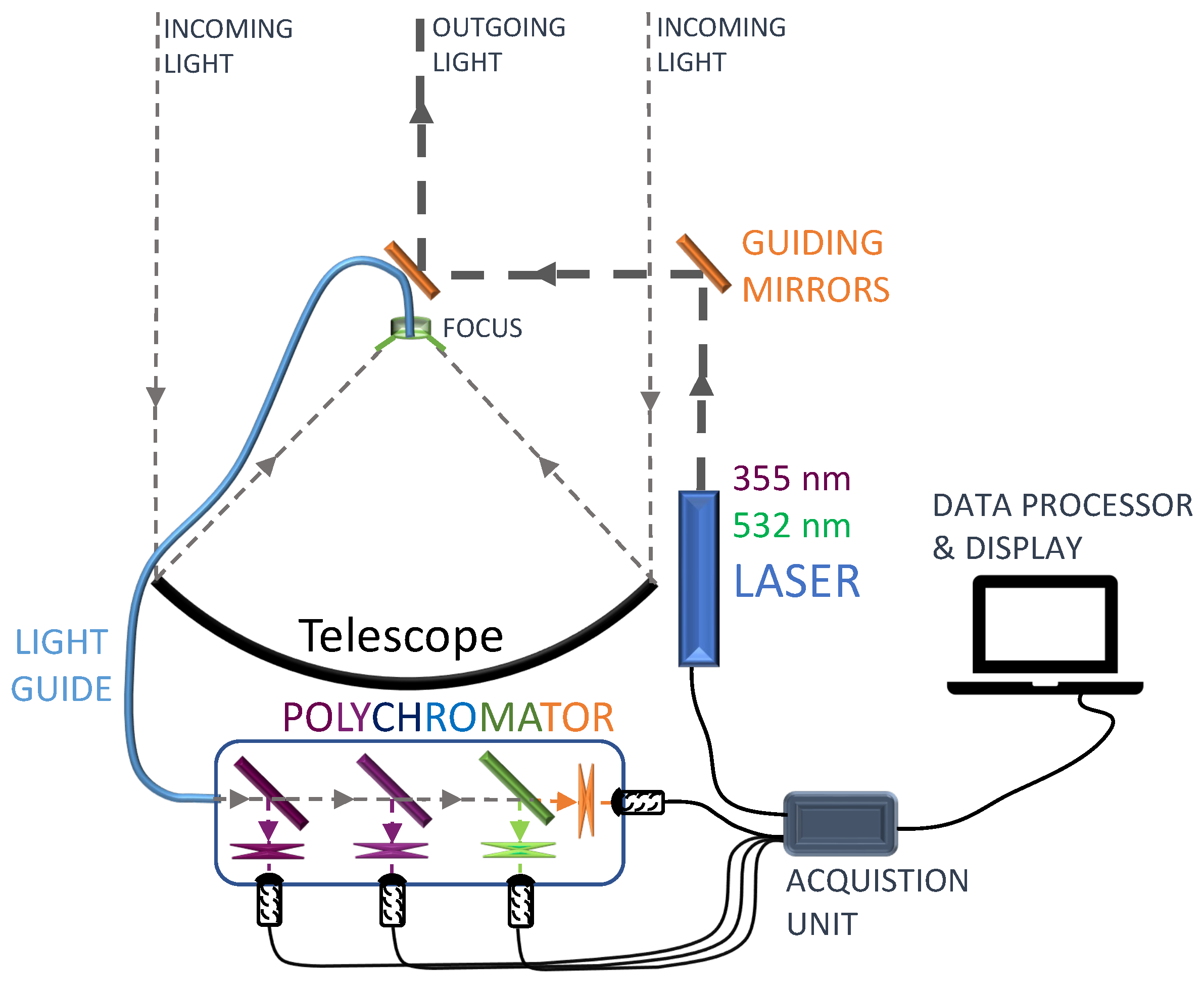
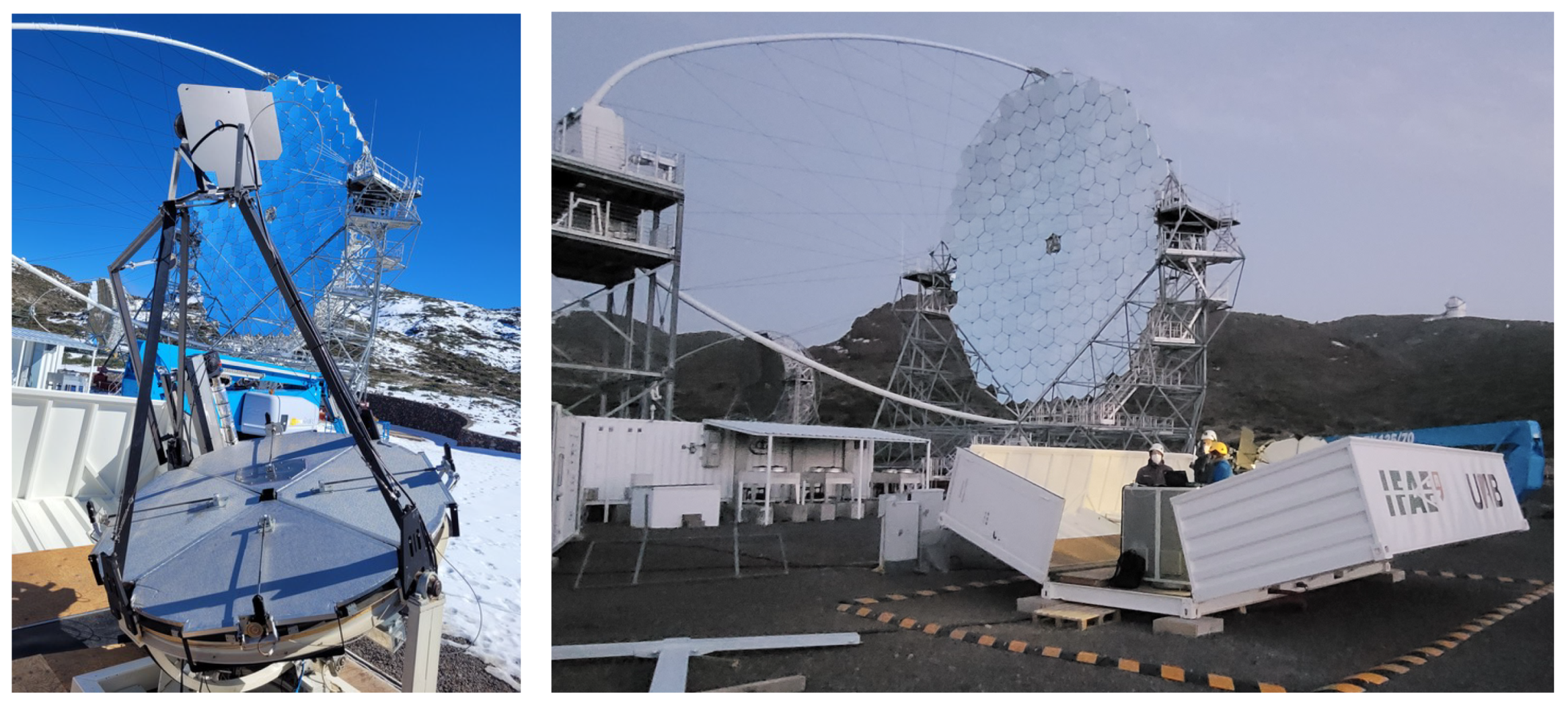

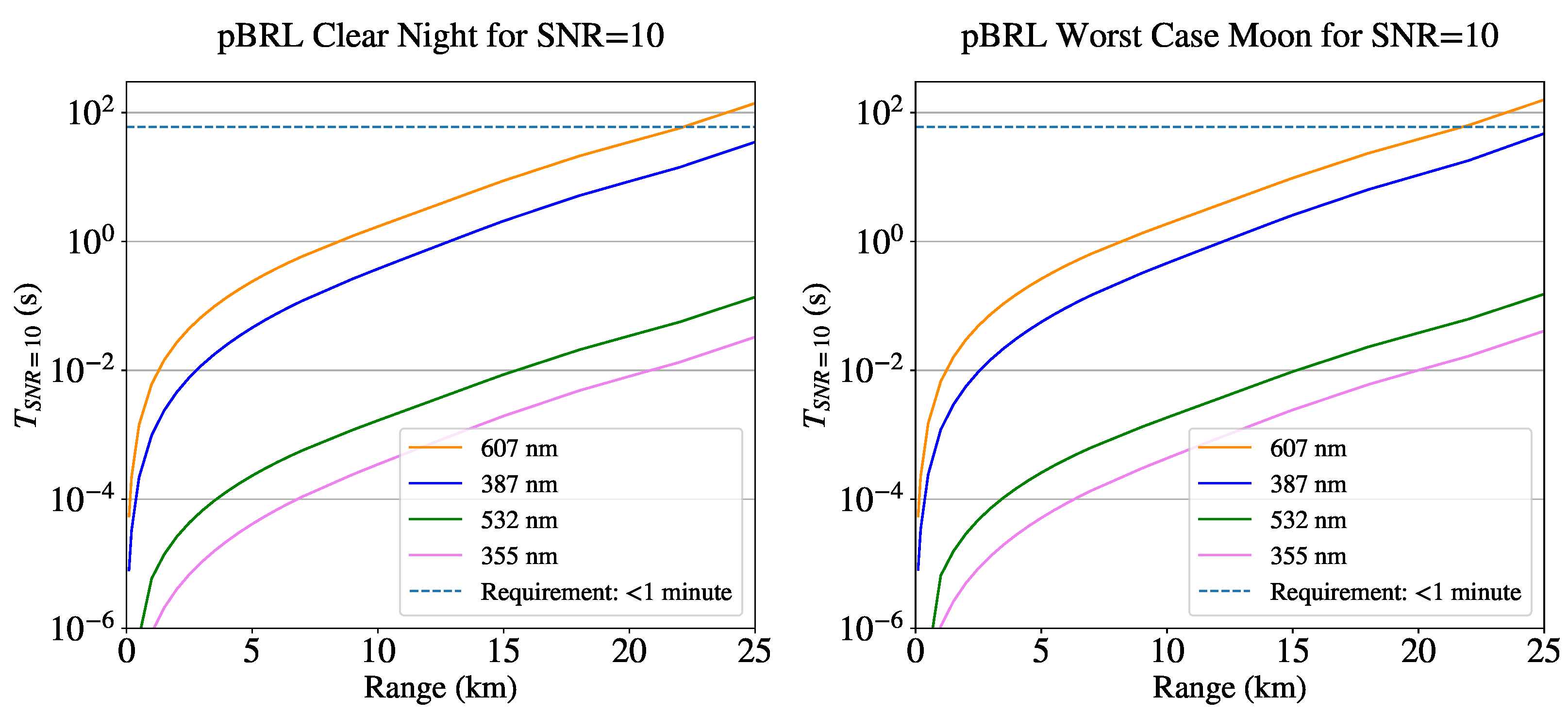
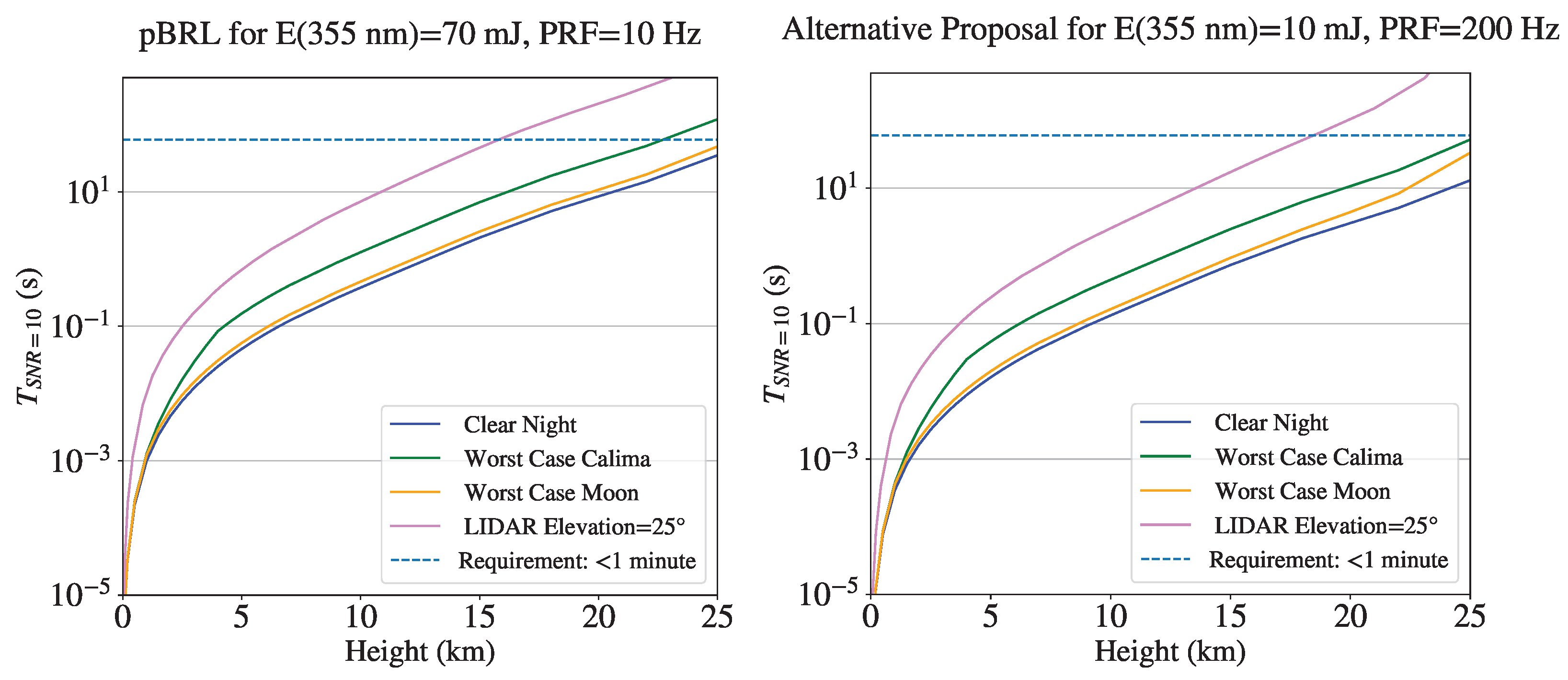
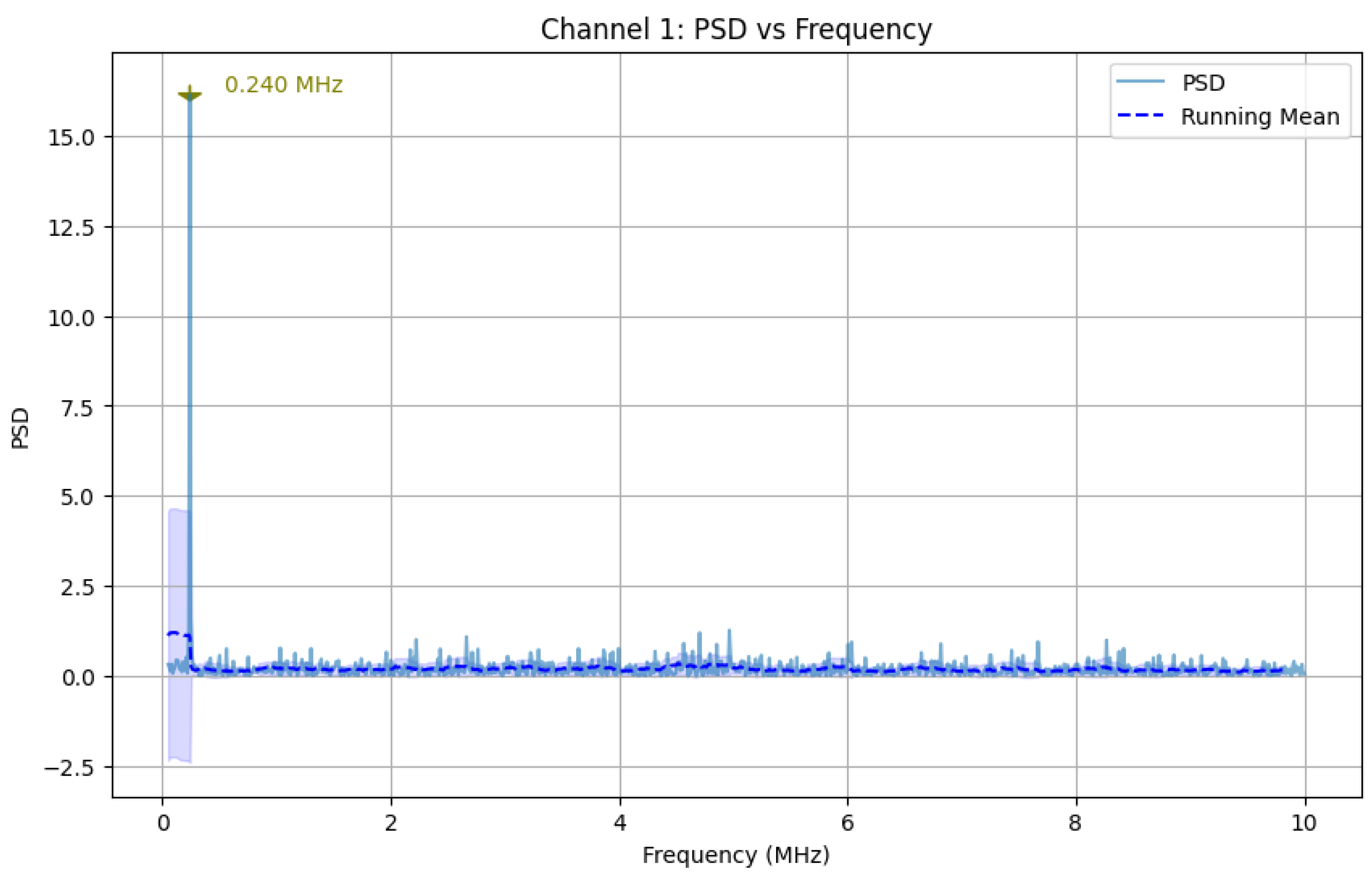


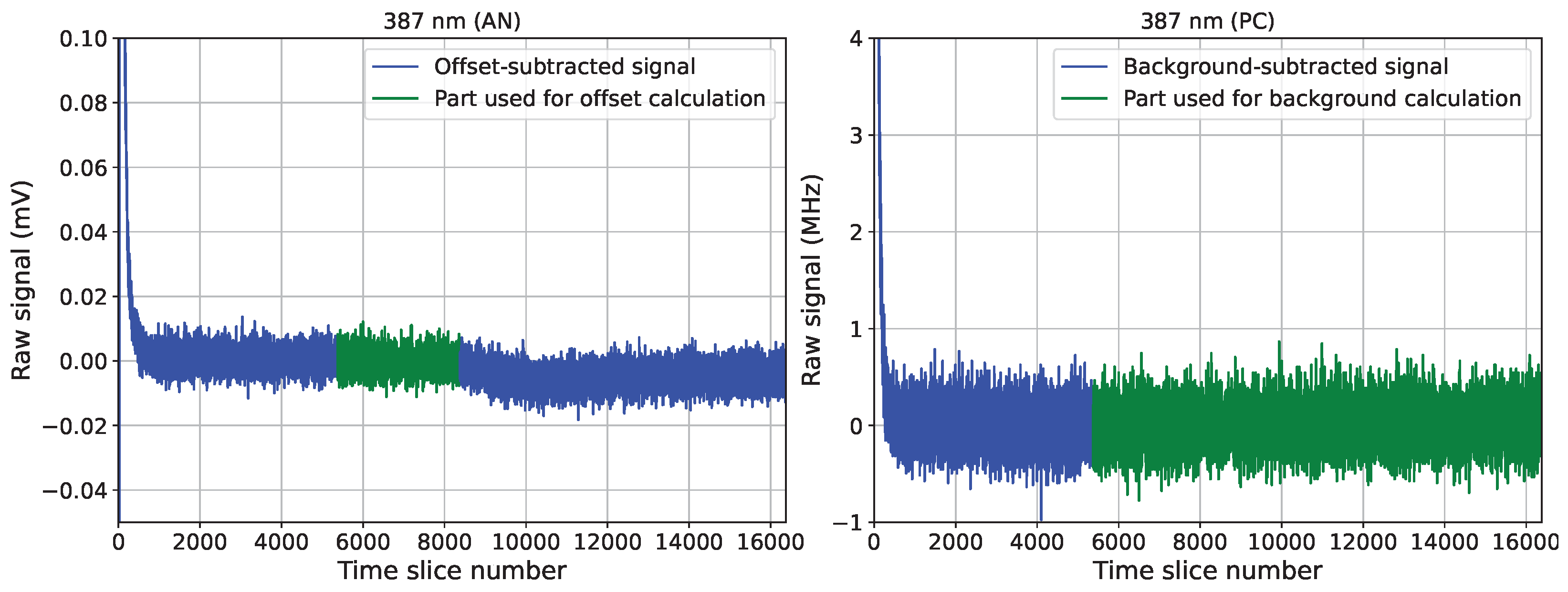
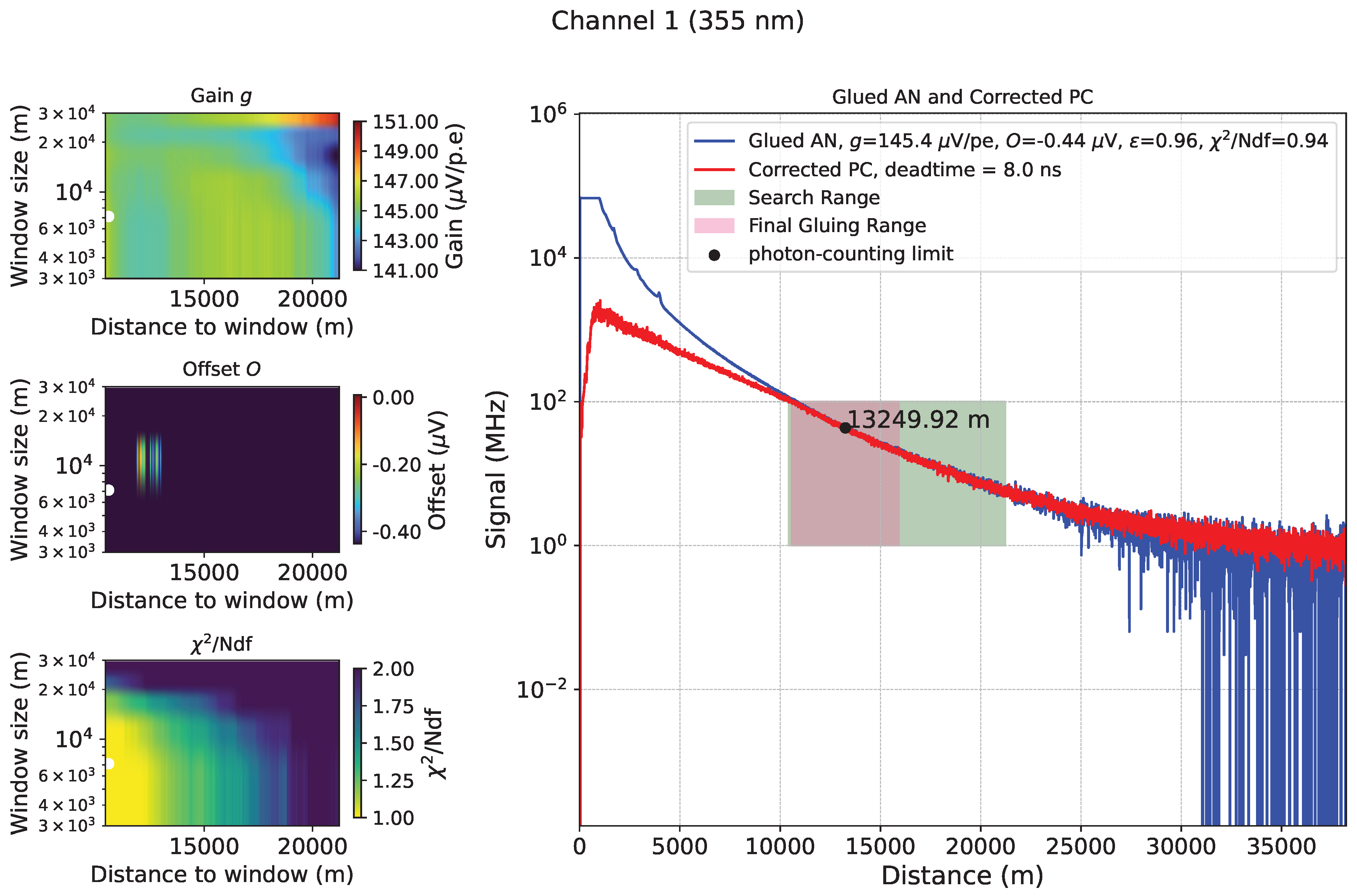
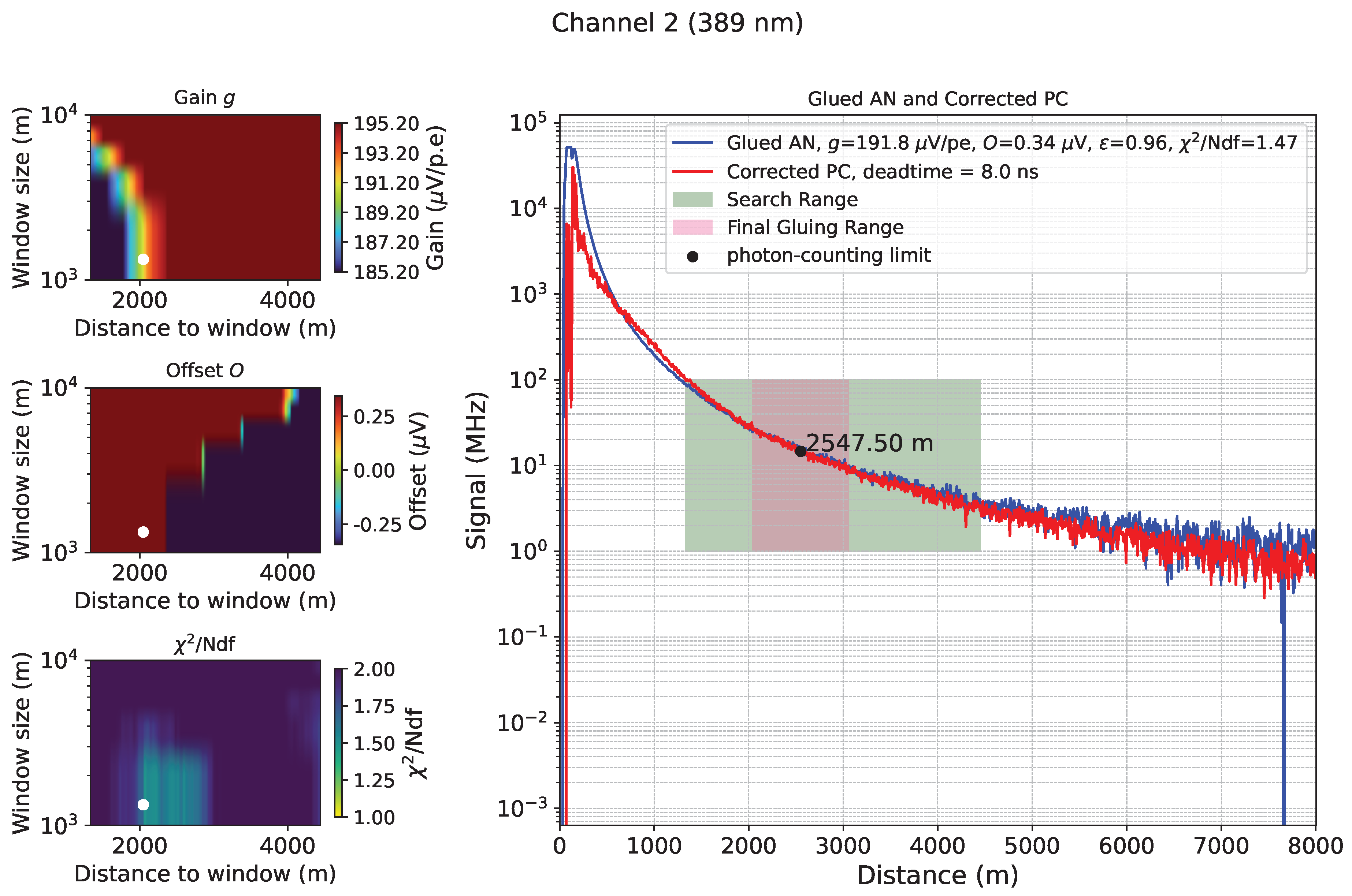

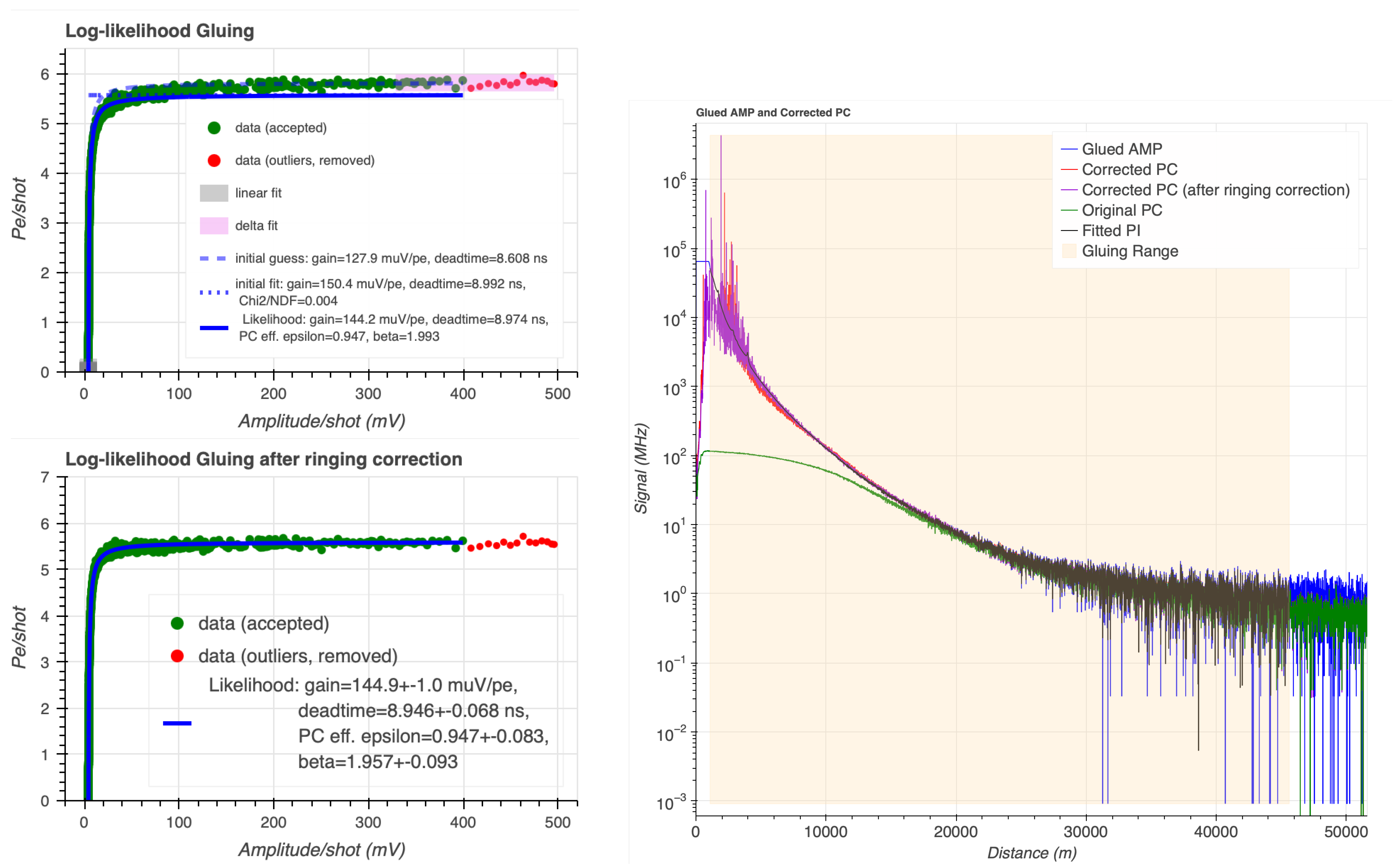


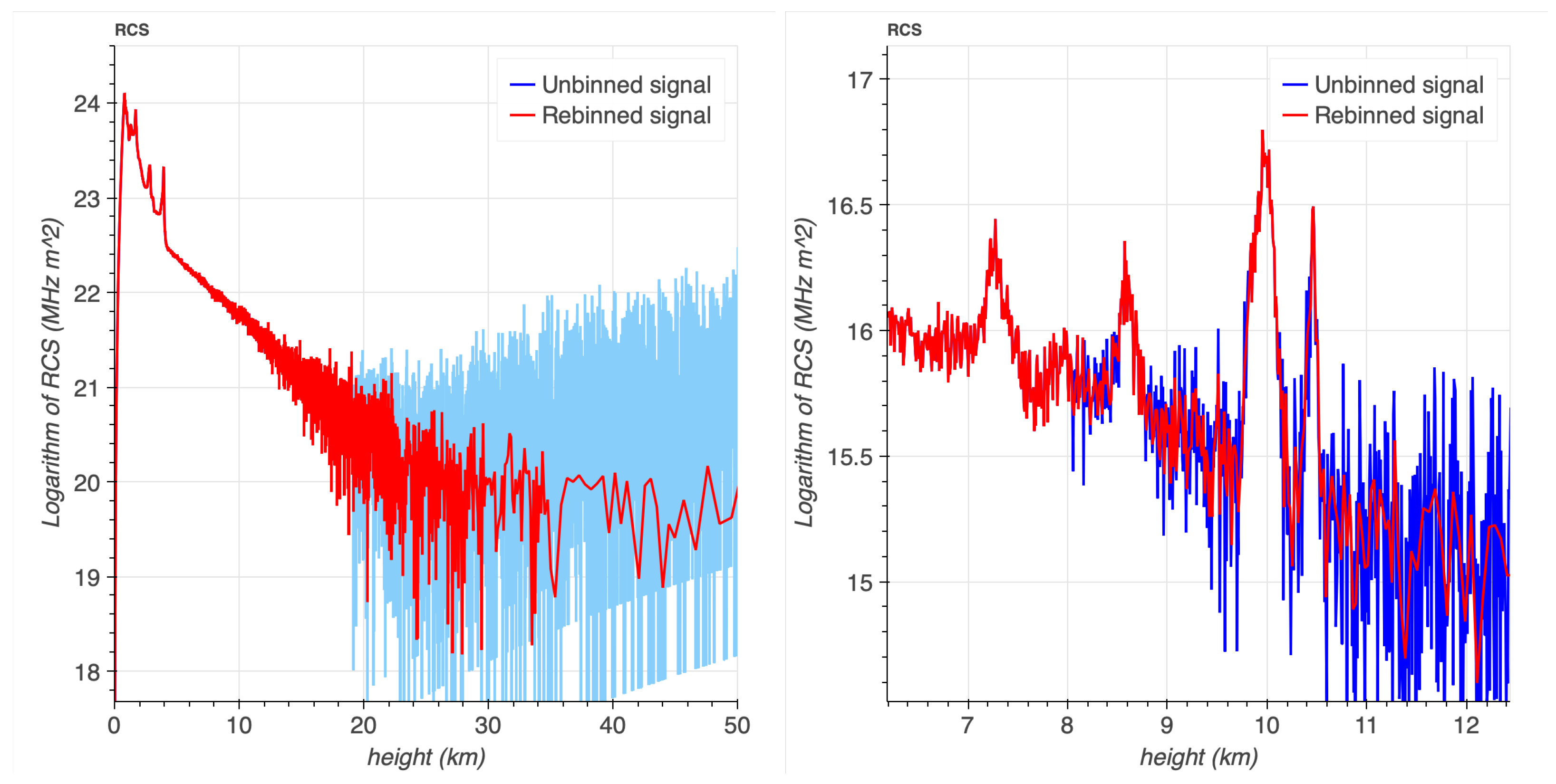
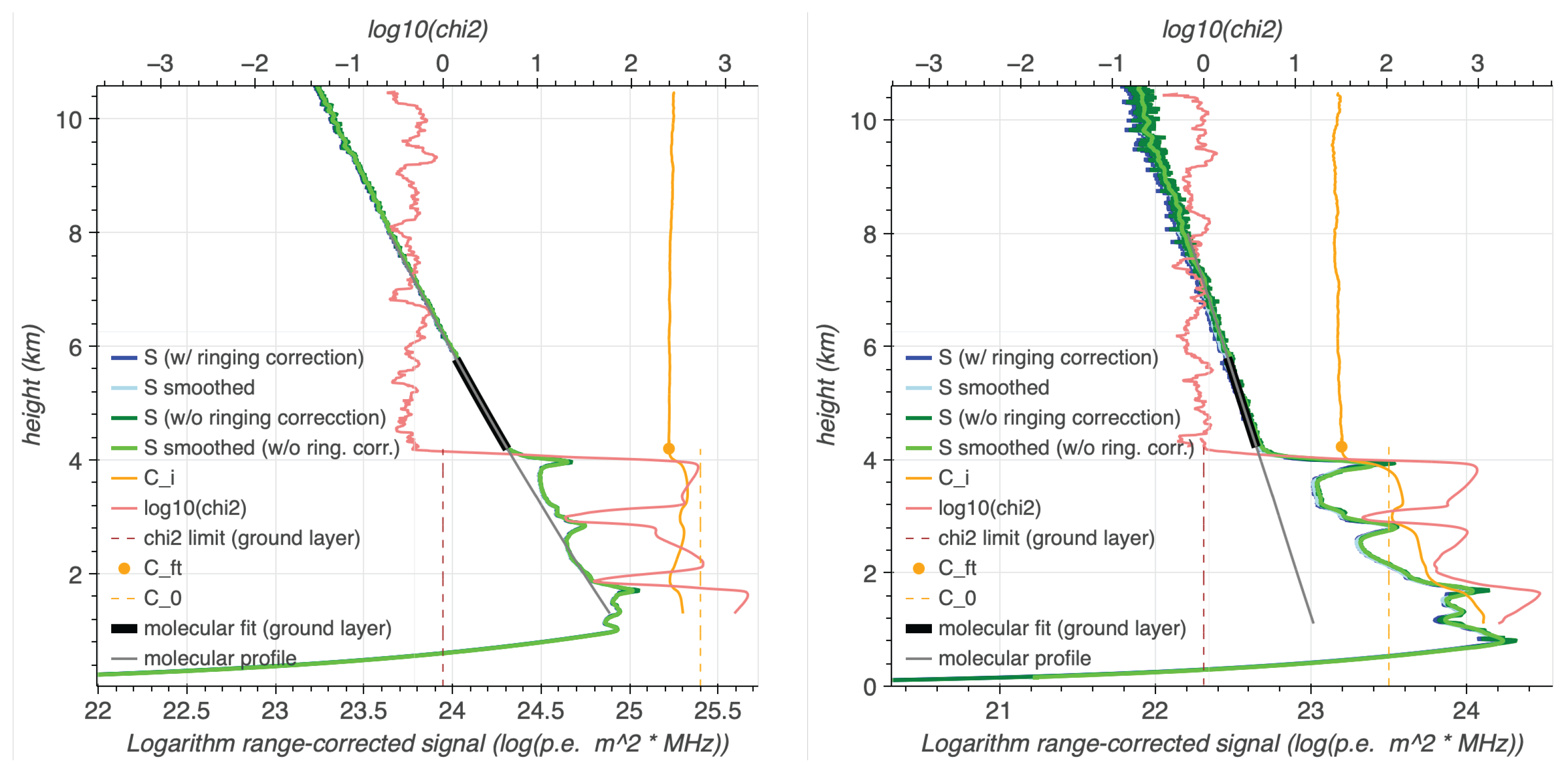
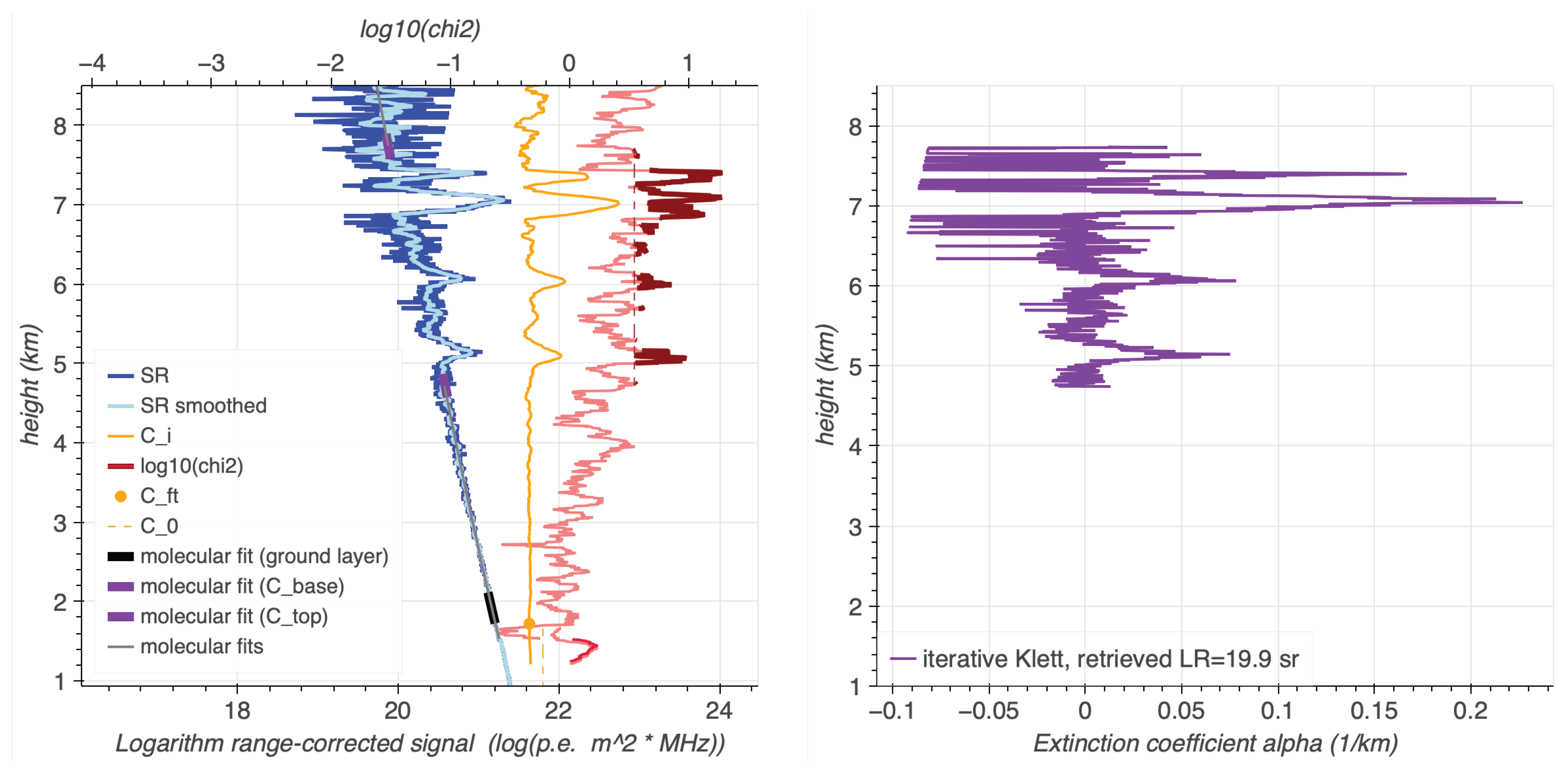
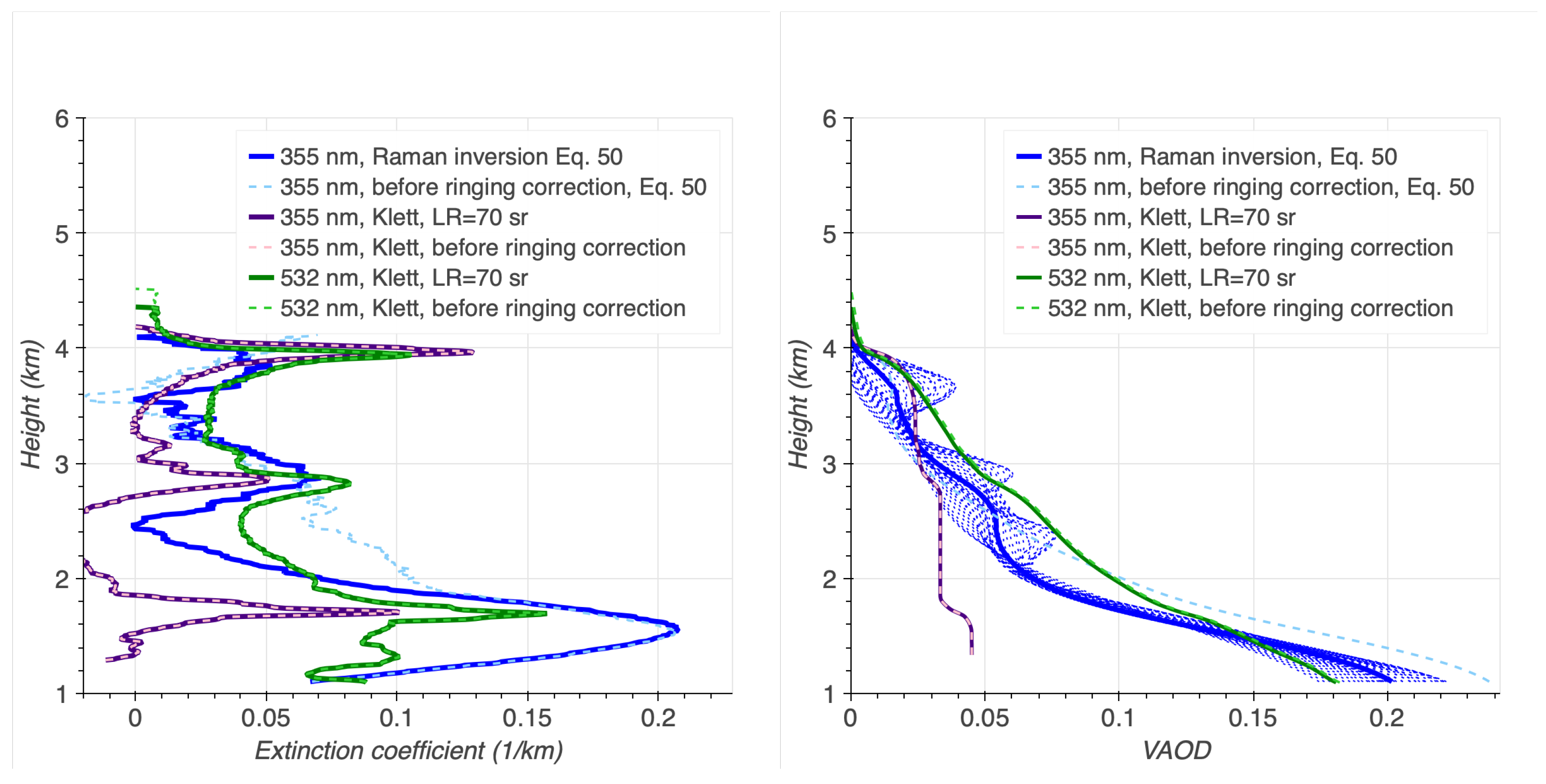

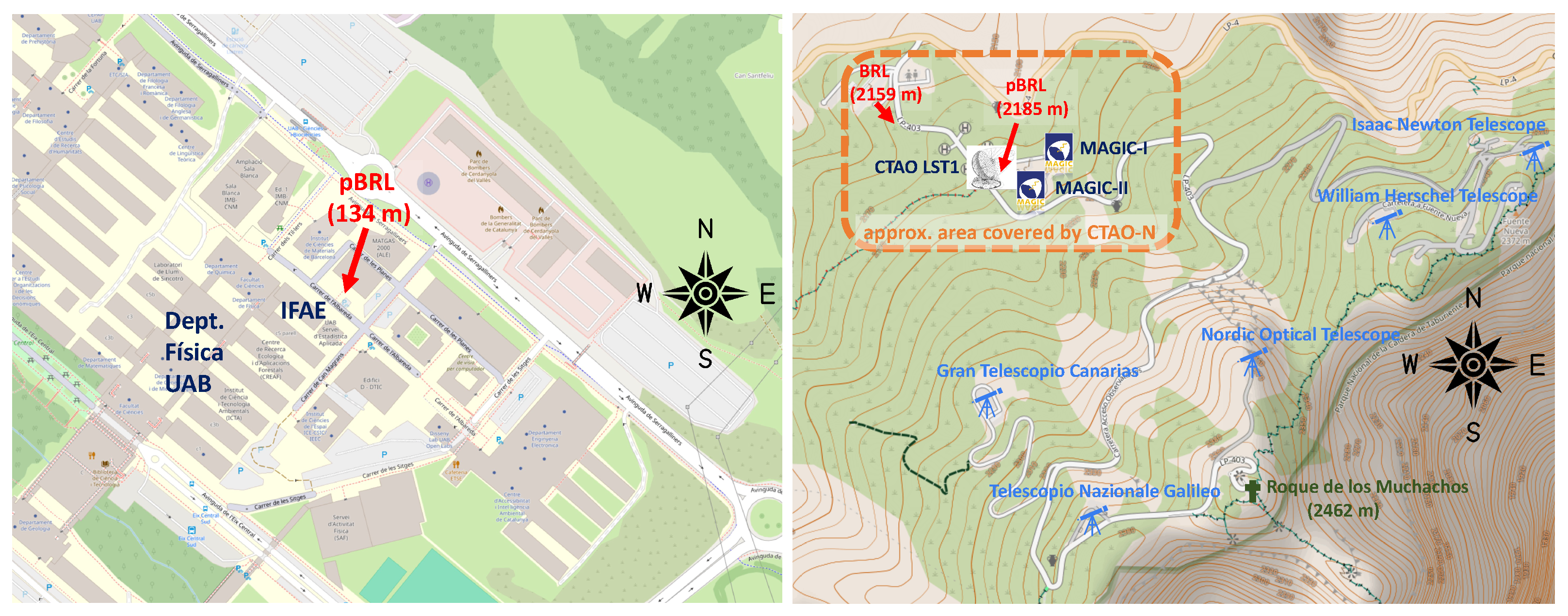
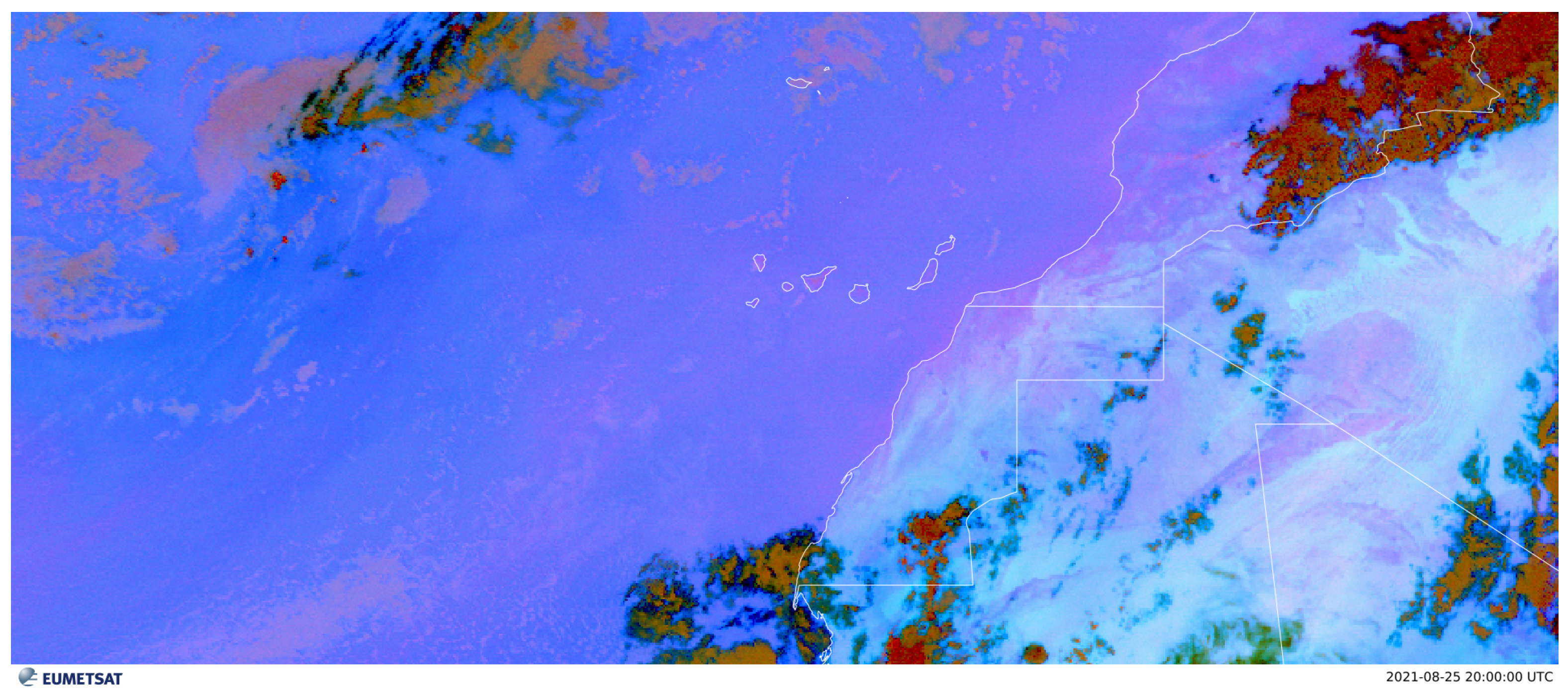

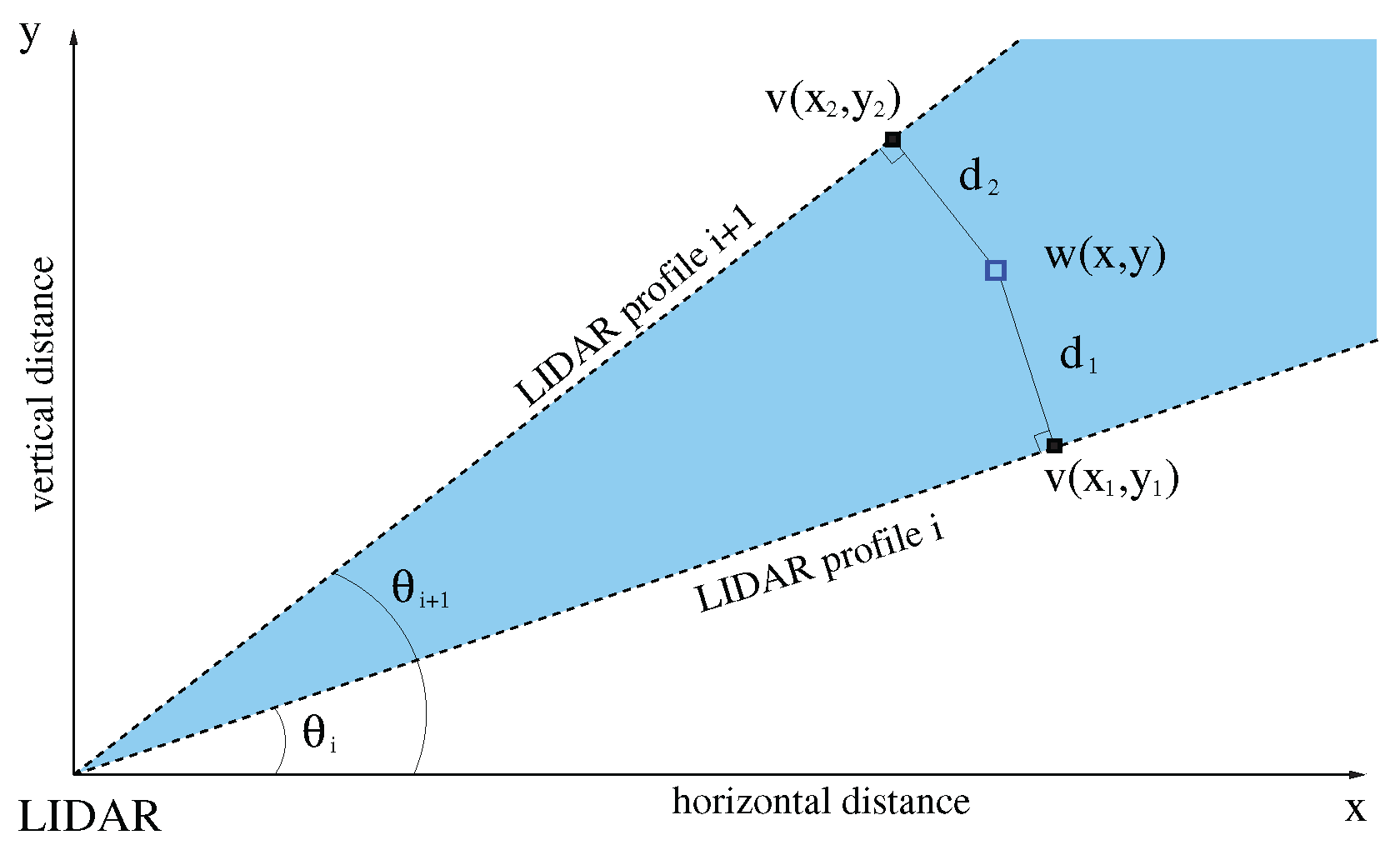





| Parameter | Value | Comments |
|---|---|---|
| A | 2.3 m2 | 1.8 m primary mirror minus shadows |
| photon counting efficiency of the readout | ||
| 355 nm channel | ||
| E | 80 mJ | energy per pulse |
| 1.4·1017 | photons per pulse | |
| l | 7.5 m | digitization length for 12-bit, 20 MS/s sampling rate |
| 0.95 | mirror reflectivity, after re-aluminization, otherwise <0.3 | |
| combined LLG and polychromator transmissions [16] | ||
| PDE | PMT photon-detection efficiency [37] | |
| 0.13 ± 0.02 | combined channel efficiency | |
| 387 nm channel | ||
| E | 80 mJ | energy per pulse (at 355 nm) |
| 1.4·1017 | photons per pulse | |
| l | 7.5 m | digitization length for 12-bit, 20 MS/s sampling rate |
| 0.96 | mirror reflectivity, after re-aluminization, otherwise <0.3 | |
| combined LLG and polychromator transmissions [16] | ||
| PDE | photon-detection efficiency [37] | |
| 0.12 ± 0.02 | combined channel efficiency | |
| 532 nm channel | ||
| E | 128 mJ | energy per pulse |
| 3.4·1017 | photons per pulse | |
| l | 3.75 m | digitization length for 16-bit, 40 MS/s sampling rate |
| 0.97 | mirror reflectivity, after re-aluminization, otherwise <0.3 | |
| combined LLG and polychromator transmissions [16] | ||
| PDE | photon-detection efficiency [37] | |
| 0.035 ± 0.009 | combined channel efficiency | |
| 607 nm channel | ||
| E | 128 mJ | energy per pulse (at 532 nm) |
| 3.4·1017 | photons per pulse | |
| l | 3.75 m | digitization length for 16-bit, 40 MS/s sampling rate |
| 0.97 | mirror reflectivity, after re-aluminization, otherwise <0.3 | |
| combined LLG and polychromator transmissions [16] | ||
| PDE | photon-detection efficiency [37] | |
| 0.05 ± 0.01 | combined channel efficiency | |
| CTAO Requirement | pBRL | BRL * | Comments | |
|---|---|---|---|---|
| Cloud | ||||
| Altitude Range | 2–20 km | ✓! | ✓ | pBRL reaches ∼35 km with the elastic lines at 355 nm and 532 nm, see Figure 28 (limited by street lighting and obtained before mirror re-aluminization). This corresponds to the requirement met for elevations higher than 35° for the pBRL. |
| VOD | 0.01–0.7 | ✓ | ✓ | The pBRL is able to detect and resolve clouds down to VODs of 0.01, see Figure 17 and VODs of at least 0.2 see Figure 26 with greatly reduced voltage settings. Higher VODs have not been observed, but should be easily detectable with canonical PMT gains of a factor of higher. |
| VOD RMSD | <0.03 | ✓! | ✓ | Iterative Klett analysis converges to correct LIDAR ratios (also in Ref. [9], where method was first implemented) above a sensitivity of . Formally, the analysis code still needs to be validated with dedicated simulations and real data sets on clouds through dedicated cross-calibrations (in preparation). |
| Base/Height RMSD | <300 m | ✓ | ✓ | Estimated m, depending on cloud height and optical thickness (see Figure 17 and Figure 26). |
| PBL | ||||
| Altitude Range | 0.5–9 km | × | ✓ | Current data sets do not cover full limiting altitude ranges, no showstoppers detected to be reached for BRL, with full operation of the near-range channels. |
| VAOD Range/RMSD | 0.03–0.7/<0.03 | ✓! | ✓ | Currently only achieved for the elastic lines over the full altitude range, and for elevations higher than 40°. The Raman line analysis retrieves the correct LIDAR ratio, but is limited RMSD by residual ringing (see Figure 18 and Figure 26). For these limiting cases, a continuous absolute calibration of the LIDAR (following Ref. [9]) is needed. To improve RMSD for the BRL, gated PMTs and fully operative near-range optics will be used [16]. |
| Height RMSD | <300 m | ✓ | ✓ | Less stringent than requirement on VOD RMSD, see Figure 18 and Figure 26. |
| Ångström RMSD | <0.3 | ✓ | ✓ | pBRL: requirement met with spatial resolution better than 100 m, see Figure 25. Accuracies needs to be validated by dedicated cross-calibrations with other instruments (in preparation). |
| Pointing | ||||
| Elevation | >25° | ✓! | ✓ | Accompanying technical paper Ref. [16]. |
| Azimuth | 0°–360° | ✓ | ✓ | Accompanying technical paper Ref. [16]. |
| Obs. Time | ||||
| Extinction Profiles | <1 min | ✓ | ✓ | pBRL: Obtained in 50 s with 500 shots at 10 Hz repetition rate, see Figure 28. BRL: Further improvements expected due to higher laser PRF. |
Disclaimer/Publisher’s Note: The statements, opinions and data contained in all publications are solely those of the individual author(s) and contributor(s) and not of MDPI and/or the editor(s). MDPI and/or the editor(s) disclaim responsibility for any injury to people or property resulting from any ideas, methods, instructions or products referred to in the content. |
© 2025 by the authors. Licensee MDPI, Basel, Switzerland. This article is an open access article distributed under the terms and conditions of the Creative Commons Attribution (CC BY) license (https://creativecommons.org/licenses/by/4.0/).
Share and Cite
Bauzá-Ruiz, P.J.; Blanch, O.; Calisse, P.G.; Campoy-Ordaz, A.; Çolak, S.M.; Doro, M.; Font, L.; Gaug, M.; Grau, R.; Kolar, D.; et al. A 1.8 m Class Pathfinder Raman LIDAR for the Northern Site of the Cherenkov Telescope Array Observatory—Performance. Remote Sens. 2025, 17, 1815. https://doi.org/10.3390/rs17111815
Bauzá-Ruiz PJ, Blanch O, Calisse PG, Campoy-Ordaz A, Çolak SM, Doro M, Font L, Gaug M, Grau R, Kolar D, et al. A 1.8 m Class Pathfinder Raman LIDAR for the Northern Site of the Cherenkov Telescope Array Observatory—Performance. Remote Sensing. 2025; 17(11):1815. https://doi.org/10.3390/rs17111815
Chicago/Turabian StyleBauzá-Ruiz, Pedro José, Oscar Blanch, Paolo G. Calisse, Anna Campoy-Ordaz, Sidika Merve Çolak, Michele Doro, Lluis Font, Markus Gaug, Roger Grau, Darko Kolar, and et al. 2025. "A 1.8 m Class Pathfinder Raman LIDAR for the Northern Site of the Cherenkov Telescope Array Observatory—Performance" Remote Sensing 17, no. 11: 1815. https://doi.org/10.3390/rs17111815
APA StyleBauzá-Ruiz, P. J., Blanch, O., Calisse, P. G., Campoy-Ordaz, A., Çolak, S. M., Doro, M., Font, L., Gaug, M., Grau, R., Kolar, D., Maggio, C., Martinez, M., Stanič, S., Ubach, S., Zavrtanik, M., & Živec, M. (2025). A 1.8 m Class Pathfinder Raman LIDAR for the Northern Site of the Cherenkov Telescope Array Observatory—Performance. Remote Sensing, 17(11), 1815. https://doi.org/10.3390/rs17111815







